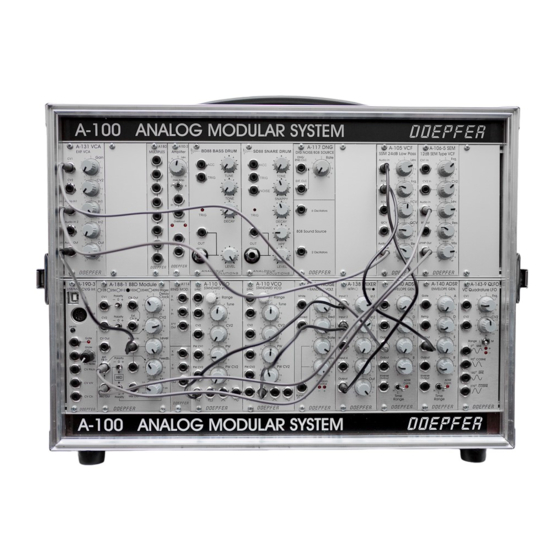DOEPFER
DOEPFER
DOEPFER
DOEPFER
=
CV Out:
CV output HSVCO
This CV output indicates the clock frequency at output
and is nothing but the sum of all CV inputs (manual, CV1
and CV2). The main purpose of this output is to control the
CV input of external low pass filters that can be used as
anti-aliasing filter and clock filter. If desired one low pass
filter can be used behind the audio output to suppress the
clock noise, especially when the clock frequency falls below
~15 khz. Another filter can be used at the audio input to
reduce the max. frequency of the incoming audio signal,
consequently reducing aliasing artefacts. As the CV output
reflects the clock frequency (affected by the manual control,
CV1 and CV2) the external filters automatically follow the
clock frequency of the BBD module. The higher the slope of
the external filter (e.g. 12/24/48 dB/octave) the better is the
clock suppression. But the CV output can be used for other
applications as well, e.g. controlling parameters of the
feedback loop like feedback amount/polarity (CV of a VCA
or VC polarizer used in the feedback loop), filter frequency
(CV of a VCF used in the feedback loop), phase shift (CV of
a VC phaser used in the feedback loop).
System A-100
4.2. BBD and Sub-Mixer Section
§
$
Ext. Clk In:
This is the clock input of the BBD section and is internally
connected to the clock output § of the HSVCO section (i.e.
it is normalled to the Clock Out socket §). If an external
clock source is used the clock output of this source is
patched to socket $. In this case the internal connection to
the HSVCO is interrupted. The clock frequency table can be
found on page 3. The required level for the clock signal is
about +3V (levels up to +12V cause no problems). This
socket can be used e.g. to synchronize two A-188-2
modules or an A-188-2 and A-188-1 (i.e. using one HSVCO
for both modules).
%
Audio In:
5
Level:
Sockets % is the audio input with the assigned attenuator 5.
Feed the audio signal that has to be processed by the A-
188-2 into socket %. Adjust the Level control 5 so that the
output signal does not distort - unless you want to obtain
distortion. For normal A-100 levels (e.g. VCO A-110)
distortion appears at about three o'clock position of control
5.
BBD Module A-188-2
BBD clock input
audio input
audio input attenuator
11

